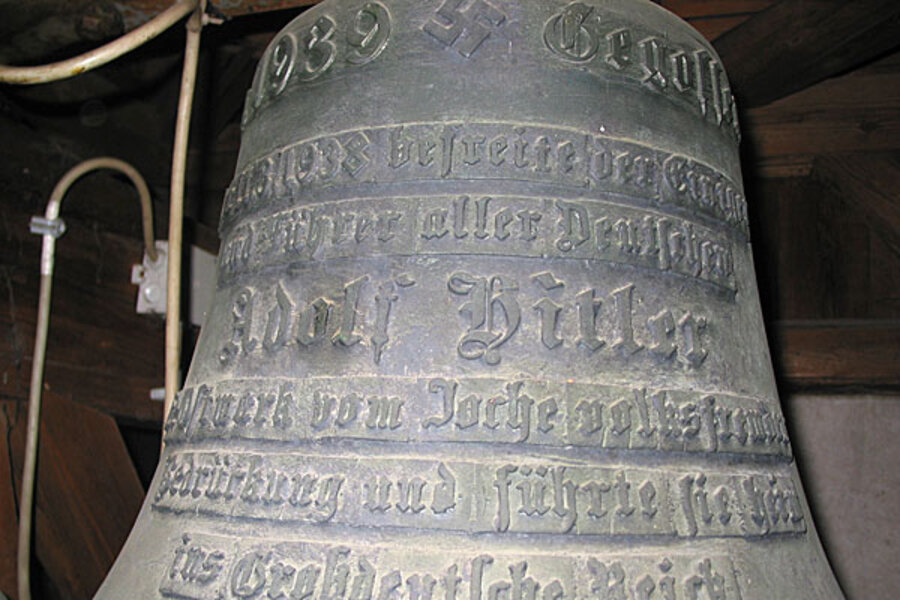Hitler's bell: Will it continue to ring in Austria?
Loading...
| Vienna
Like many others in Austria's countryside, a tower bell above the red-tiled rooftops of Wolfpassing village marks the passing of each hour with an unspectacular "bong." But this bell is unique: It is embossed with a swastika and praise to Adolf Hitler.
And unlike more visible remnants of the Nazi era, the bell was apparently overlooked by official Austria up to now.
Ensconced in the belfry of an ancient castle where it was mounted by fans of the Nazi dictator in 1939, the bell has tolled on for nearly 80 years. It survived the defeat of Hitler's Germany, a decade of post-war Soviet occupation that saw Red Army soldiers lodge in the castle and more recent efforts by Austria's government to acknowledge the country's complicity in crimes of that era and make amends.
Some of those efforts have focused on identifying relics of that time and ensuring they're either removed or put in historical context. As an example, officials often cite government moral and material support for the restoration of the Mauthausen concentration camp, where a museum documents atrocities for school children and other visitors.
The Wolfpassing bell pays homage to Hitler for his 1938 annexation of Austria, a move supported back then by the vast majority of the nation's citizens. It describes Hitler as "the unifier and Fuehrer of all Germans" and says he freed the "Ostmark" — Nazi jargon for Austria — "from the yoke of suppression by foreign elements and brought it home into the Great-German Reich."
Local historian Johannes Kammerstaetter says most villagers would have known about it. But village mayor Josef Sonnleitner asserts even the villagers had no clue until the first media reports last month on the "Fuehrerglocke," or "Fuehrer Bell."
"Nobody cared until all this publicity," he said on the telephone. He refused a request for a longer interview, saying he was busy for the next two weeks with haying.
In any case, the government's recent sale of the castle — with all its historical trappings — has suddenly made the bell an issue beyond the sleepy village of 1,500 people about 100 kilometers (60 miles) west of Vienna.
In a country particularly sensitive about suggestions it has not fully faced its Nazi past, officials are scrambling for explanations of why the bell apparently evaded notice for so long. They also are under pressure to justify a ruling by the government agency in charge of historic monuments that it must remain part of the castle as part of its heritage— despite the refusal of the new owner to say what he plans to do with it.
Propagating Nazi values or praising the era is illegal in Austria. Kammerstaetter, the historian, has formally asked state prosecutors to examine whether the government's sale of the bell is a criminal offence. He says the change of ownership could constitute a case of "spreading National Socialist ideology" on the part of the government agency in charge of state-owned property
Raimund Fastenbauer, a senior official of Vienna's Jewish community, invokes other concerns, noting that other Hitler-era relics like the dictator's house of birth in the western town of Braunau have become a magnet for neo-Nazis.
"I think the best thing would be if the bell disappeared and was buried somewhere," he says.
For its part, the government says that the sale was legal, along with the decision to keep the bell in the belfry as an integral component of the castle.
Economics Minister Reinhold Mitterlehner says the agency overseeing the sale was not aware of the inscription.
He notes in a letter to Kammerstaetter that "the bell up to now was neither publicly displayed nor generally accessible," adding that he does not see the sale as constituting a criminal offense.
Ernst Eichinger, a spokesman for the agency responsible for government real-estate, says that with a portfolio of more than 28,000 buildings — many of them huge — "we cannot search every centimeter" before a sale.
Concerns are heightened by the lack of clarity about what the new owner, Tobias Hufnagl, plans to do with the relict. Two web domains linked to him or his holding company, hufnagl.cc and thinvestments.com, did not open.
Sonnleitner, the Wolfpassing mayor, says has not been able to directly contact Hufnagl, despite weeks of trying.
In a terse email this week responding to numerous Associated Press queries seeking permission to film the bell and asking about its fate, Hufnagl said he had "no interest" in exchanges with the AP.
Copyright 2013 The Associated Press.







